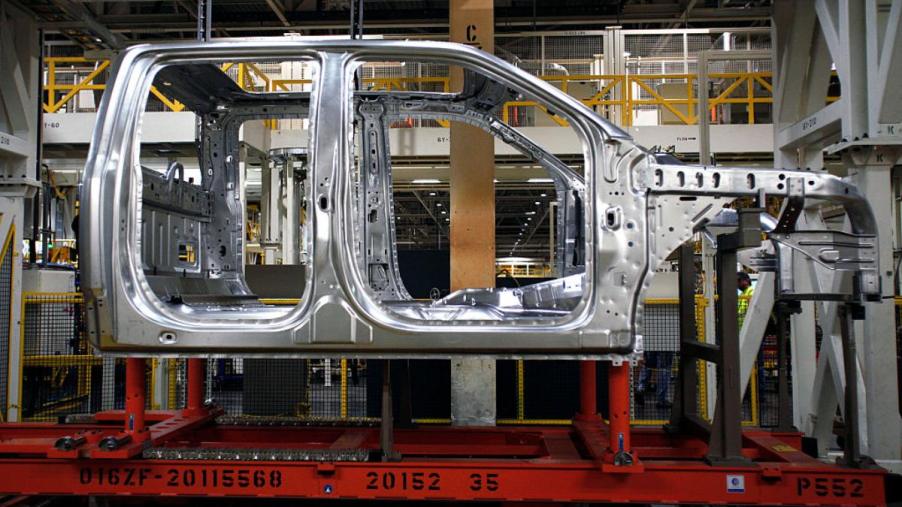
When Did Ford Switch to Using Aluminum to Build F-150s?
Truck sales are very competitive, and the automakers generally all follow the same trends. In a world of uniformity, why did Ford change the F-150 to have an aluminum body? Let’s take a look at the reasoning behind the switch and the impact it’s had on the pickup truck segment.
The Ford aluminum F-150 debuted 2015
Ford switched its F-150 truck body to aluminum on the 2015 model. It was an expensive switch, but it improved Ford’s sales and helped take more of the truck market from Chevrolet and Ram. Since the change, the Ford F-series has continued to be the U.S.’s best-selling pickup, a title it has held for more than 40 years.
In its 2014 press release announcing the use of aluminum on the F-150, Ford shared that the new model year F-150 would include more high-strength steel in its frame, up from 23% to 77%. The change made the frame more durable, more rigid, and 60 pounds lighter.
With the change to a military-grade aluminum-alloy body along with the high-strength steel frame, the F-150 became 700 pounds lighter and could tow and haul more while using less gas. Ford made sure to test the new design under various tough conditions to make sure the truck would hold up well under any customer demands.
Ford’s strategies
In an interview with AutoWeek, Ford marketing manager Brian Bell, who handles the F-150 and Ranger, said,
“Everybody’s got a different strategy. They all look at their own programs in different ways. We think what we did has been the perfect choice for us.”
Ford has continued to be pleased with its jump to aluminum. The F-series’ share of the full-size pickup market has grown, and prices have increased. The F-150 was also the first full-size pickup to get better than 30 MPG (with the diesel engine). Ford has also started using aluminum on its other large vehicles, including the Super Duty, Expedition, and Lincoln Navigator.
Ford’s aluminum strategy comes out of a different history from the other manufacturers. Before the change, the F-150 had a higher weight than its competitors.
In addition, Ford already had a background in working with aluminum bodies and had changed the Jaguar XJ sedan to aluminum in 2003. The interest in aluminum helps to differentiate the F-150 and underscores Ford’s commitment to smaller engines and fuel economy.
Do rival trucks use aluminum?
The three truck companies in Detroit—Ford, Chevrolet, and Ram—sell 83% of light-duty pickup trucks in the U.S. At the time, it looked like other manufacturers would also switch over to aluminum to decrease their trucks’ weight and increase fuel economy.
Ultimately, competitors chose not to switch to aluminum, sticking primarily with steel bodies and beds. Manufacturers also explored new materials like carbon fiber and magnesium. Auto manufacturers stuck with steel for their truck frames because it is two or three times stronger than even the highest-grade aluminum.
Chevrolet has been especially critical of Ford’s aluminum truck beds, using its commercials to show that an aluminum truck bed could be damaged. However, the 2019 Chevrolet Silverado does include some aluminum and weighs 450 pounds less than the 2018 model. While the fenders, roof, and bed are still steel, the doors, hood, and tailgate were switched to aluminum.
The Silverado’s safety cage is made from seven grades of steel, and the frame uses high-strength steel. Fiat-Chrysler, which owns Ram, uses mostly steel on the 2019 Ram 1500, although some aluminum and composite materials are used to keep the weight down. The weight has been reduced by 255 pounds.
The pros and cons of aluminum truck bodies
As with any change, there are pros and cons. The aluminum body does help the 2020 F-150 get great gas mileage. While the F-150 is designed to be dent resistant, it can be prone to early corrosion and paint issues. In addition, aluminum is more expensive than steel, which increases both the price of the truck and some repairs later on. However, concerns about big increases in repair costs have turned out to be unnecessary.
Since Ford switched to the aluminum-body F-150, the company has been pleased with the results. But if buyers have concerns about aluminum, they can still turn to the Chevy Silverado or Ram 1500.


